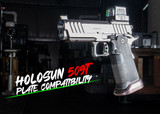Why our bases don't use recoil lugs.
Why our bases don't use recoil lugs
When we mount a scope on a receiver we have to make choices. Which scope mount, which set of rings. There are many choices on the market and everyone makes their mounts and rings a little bit different. Some are picatinny, some are weaver, some use recoil lugs, others don't.
One of the most common questions we receive is; "Why do you use tapered head screws and not recoil lugs?". It turns out that receiver's dimensions are not always consistent. When receivers are machined inconsistently, measures must be taken to ensure proper fitment of your mount. There are two popular options to work around this issue. One is to machine slotted holes in the mount to allow use of flat bottom screws and an integrated recoil lug. The other option is to have self centering screws with tapered heads. The screws act as recoil lugs and any inconsistency in spacing is worked out in the tolerances.
We found there are issues that can arise when using flat bottom screws with a slotted, recoil lug base. One of the largest issues we have found is, you fire the gun and the scope, rings and rail move forward in relation to the gun and eventually, hopefully stop on the recoil lug.
Our issue with this is the following: the scope moves forward and the rifling twist loads the base to one side or the other. Bump the scope in the opposite direction and it can move. Torquing the screws further to combat this is not an option, the base screws are limited to 20 or 22 inch lbs.
By using 4 screws (typically) with an 82 degree countersink, the screws center the rail over the average of the 4 screws.
The countersink also locates the rail front, back and side to side, not just front to back like the slotted style. The same amount of torque is applied to attach the rail but with much more contact since the countersink increases the area of contact.
Most receivers are round on top so they tend to keep the rail straighter front to back hugging the radius. #8-40 screws are Better. Larger is better.
Then we have our screws made in Pa. We use the industry standard for SHCS fasteners 4037 except we slightly bump the hardness above what is spec for Grade 8.
Several years ago we went to Torx shaped screws which are also an improvement over hex drive screws.
In Europe some manufactures use location pins to hold the rail in place and screws to simply hold the rail on. We are looking at a front pin to standardize location for this purpose.
Really light guns with really heavy scopes using #6 screws is why we are looking at this but all mounts would benefit. I also understand that people, myself included are not super psyched about adding a hole to their 700-7000.00 rifle. CNC will typically drill and tap the mounting holes. It is possible that at the same time, in the same hold and operation a pin could be added going forward.
We would encourage blue locktite on the screws. Degrease the screws and receiver before installing and avoid pouring locktite into the action trigger etc.







